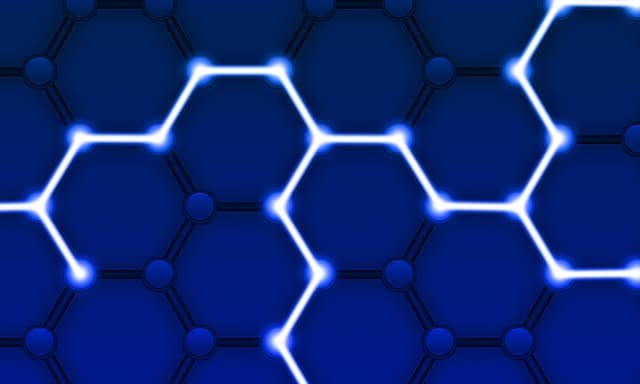This article provides a brief, easy to understand, non-technical explanation of Blockchain technology and its features, including those that have given it the reputation of being “disruptive”.
Blockchain Technology
Blockchain has been called the “internet of value” (FAO and ITU, 2019) and is, in the simplest terms, a digital, distributed “ledger of assets and transactions” (Hammerich, 2018), with “mechanisms for processing, validating and authorizing transactions” linked with anything that is considered to have ‘value’ (FAO and ITU, 2019; Kochupillai, 2019a). While being a complex technology, it is largely a combination of several existing and well-known mechanisms. In particular, it is a combination, inter alia, of methods for implementing software systems (especially de-centralized, distributed, and peer to peer systems) in a way that maintains their integrity, transparency and immutability; a method of data storage and transmission; and a programmable platform that permits new applications (distributed applications or dApps, and smart contracts) to be built upon it (Drescher 2017, pp. 6-7, 24; Finck 2019, p. 8).
For non-technical audiences, it is quite easy to conceptually understand the possibilities offered by blockchain, without needing to fully understand its technical inner functioning. This is attempted herein below.
Understanding Blockchain: Its Unique Features
Blockchain, or the more generic Distributed Ledger Technologies (DLT), are best understood by remembering how we keep accounts and what the common problems in single copy or centralized accounting systems are. Let’s say that Mary is keeping a record of how much money she has loaned to Rama, Josef and Mira. Her accounting book also records the date and time on which each or any of them returns the money or borrows more money. In a situation where Mary is the only one entitled to keep a record of the transaction history, there is an inevitable need for Rama, Josef and Mira to trust Mary and her accounting system completely. Mary, in turn, must not only act in complete good faith at all times, but must also be certain that her single and only copy of all accounts is up to date and not tampered with by anyone (including Rama, Josef and Mira). In case of errors, whether resulting from deliberate entering of false transactions or simple human or technical mistakes, there is no other copy of the accounts one can turn to, to check where and how the mistake/error occurred. Here, therefore, we identify some of the most common problems linked with centralized accounting systems:
- the need to rely on (trust) one central agency that has all the power and infrastructure to keep records;
- the lack of traceability, transparency and decentralization that can help identify mistakes and/or evidence of tampering or corruption (lack of trust in the system);
- the need to rely on (trust) the services of an intermediary (in our example, Mary and her record) to confirm the state of one’s accounts and to make additional transactions; and
- even in cases of multiple copies of transaction histories, there is the lack of a means of checking (periodically or regularly), whether all copies are true, identical and up to date (lack of trust in veracity of data). In sum and substance, therefore, almost all problems linked to centralized record keeping can be summarized as problems associated with trust, or the lack of it.
Now, imagine that instead of having just one copy of the accounting book, centrally managed by Mary, we create a digital system where each individual in our example system, namely, Mary, Rama, Josef and Mira, have complete copies of the entire money transfer and return (transaction) history. Add to this, the possibility of regular checks to ensure that each transaction entered in any copy of the accounting book can be traced to its source and independently verified by predetermined (based on mutual consent of participants) methods before it is entered in other

copies. In this system, because each participant has an updated digital copy of the transaction history, no single person can be defrauded without he/she coming to know almost immediately. This also eliminates the need for an intermediary (Mary) to execute any new transactions. Thus, for example, Rama can borrow money not only from Mary, but has a record of the entire transaction history which permits him to borrow also from Mira if she has the required funds and offers a lower interest rate. Finally, imagine if to ensure that transaction records entered and confirmed in the past cannot be amended or deleted (tampered with) sometime in the future, the system is an ‘append only’ one which ensures permanent and non-amendable record keeping in all copies. These features are an integral part of DLT/Blockchain technology.
The above features of Blockchain technology, discussed in a simplified manner in our example, are described or referred to using the following terms:
- (i) decentralized and distributed (rather than centralized) record keeping in multiple copies, with each network ‘node’ (participant) carrying a complete copy of the transaction history;
- (ii) trustless, computational (rather than human) and automated verification of system integrity (including data integrity, i.e. the data in the blockchain is complete, accurate and consistent, and behavioral integrity, i.e. the system is functioning the way it is meant to); and
- (iii) immutable record keeping that maintains a record of the entire transaction history in a sequential, traceable, transparent and (hopefully) tamper-proof manner.
Together, these features permit tracking and tracing of transactions to their source (provenance), while also preventing tampering attempts. In short, blockchain reduces the need to trust centralized human agencies. Instead, trust is placed in the hands of algorithms designed by the blockchain community, which implement the protocol agreed to by the community. It has been said that “if humans repeatedly fail to build trust, perhaps algorithms should replace them.” (Chapron 2017).
Data Security
The question that still remains is that of (iv) data security. Here, blockchain uses another age-old feature, namely cryptographic hashing, that permits data subjects to better manage and control who has access to their (personal) data. Blockchain/DLT may also help accomplish the goal of data portability (including by incentivizing data sharing and automating payments for shared data), thereby supporting the establishment of a data economy envisaged by the General Data Protection Regulation (GDPR) (European Parliament, 2019, p. III). Undoubtedly, there are still several shortcomings in the technology that make it susceptible to the same risks as in existing centralized systems. Nevertheless, the above features of blockchain, together with the fact that it is also (v) a programmable platform that permits new applications, including smart contracts, to be built on it, make Blockchain/DLT a highly attractive option for several use cases. Smart contracts execute money transfers without the need for any intermediary, especially when cryptocurrencies are adopted. Undoubtedly, the technology is still in its nascent stages of development and user adoption is relatively low due to the greater convenience (currently) of centralized systems. Nevertheless, Blockchain can significantly reduce transaction costs and the need for interventions by regulatory authorities. It has been estimated, for example, that “blockchain could facilitate global savings of up to US$6 billion per year in business transactions” (Addison and Lohento, 2018).
Would the role of governmental and law enforcement agencies then be eliminated in a blockchain world? No. Instead, perhaps more accurate would be to say that their role, power and authority will become more distributed, transparent and/or susceptible to contradiction or verification by independent stakeholders. Further the value of their certifications and regulations would depend on how much each individual player (e.g. buyer of seeds) chooses to rely on their authority. Accordingly, attributes like quality and reliability, which are currently considered ‘objectively verifiable’ based on certification requirements of centralized authorities, may become more and more ‘subjective’, varying based on which ‘node’ any stakeholder considers on personal judgement and experience to be reliable, and which attribute (e.g. of the seeds being sold) is being sought by the buyer. The establishment of such a system, is not, however, without its challenges – both technically and practically speaking.
Why Is Blockchain Considered A Disruptive Technology?
Blockchain is considered a disruptive technology because in addition to “promising innovation in the financial and commercial area comparable to the impact that the Web had on communication” (Godinho, 2019), it permits data source and use to be tracked and confirmed (increases transparency), and permits data subjects to directly manage and monetize the use of their data. Further, eliminating the need for trusted intermediaries, permits data subjects to directly enter into transactions with other data subjects (peer-to-peer transactions) without incurring transaction costs.
Take for example, the seed sector. Currently, consumers rely on centralized seed certification agencies to determine which seeds are of the required quality. Indeed, the law requires that only certified seeds are sold in the market in the first place. However, in a blockchain world, supported by legislations like the new EU Organic Regulations (EU 848/2018) that do not require certain categories of certification for ‘heterogenous materials’, there would be no need for a seed seller to wait for a centralized agency to “certify” the quality of her seeds. Not surprisingly, therefore, Blockchain, is also envisaged as a means of (re)distributing wealth and power in many hands rather than in just a few.
Any player (“node”) on the blockchain can perform a test and upload the test results on the blockchain, thereby adding valuable information as to the quality of the heterogenous seeds to the blockchain and making the seeds more attractive to buyers even in the absence of official certification (Kochupillai, 2019a). The apparent elimination (or bypassing) of the need to trust a single centralized certification agency is one of the key reasons why blockchain is considered a disruptive technology. It is noteworthy here that what is eliminated is the need for and reliance on one centralized certification agency. However, even in a blockchain world, certification would still be valuable. It would facilitate certification of a variety of desirable features (including those that may currently not be tested), by multiple players rather than by just one central agency. Checks and balances will, undoubtedly, still need to be built into the system – even this role can be played by various ‘nodes’.
Blockchain is also increasingly recognized as a means of incentivizing activities and business models that are not optimally incentivized by existing regulations such as intellectual property regimes (Kochupillai et al. 2019). These activities and business models include, for example, those that support social, economic and environmental sustainability, increase democratic and transparent decision making and permit equitable development and enrichment also of poorer and marginalized segments of society. It has been said that “disadvantaged market participants can have a sort of ‘seat at the table’ through this technology“ (Hammerich, 2018). This is accomplished by smart contracts and “cryptogovernance” that outsource “trust, law and enforcement” to “computer code” (Chapron 2017).
Types Of Blockchain
Blockchain technology has evolved rapidly since its first use case, Bitcoin. Now, a blockchain can be a consortium blockchain (“a consortium created and controlled by a group of members”), a private blockchain (a “centrally controlled blockchain which only permits specific authorized members to add records to the transaction history”) or a public blockchain (the “original blockchain architecture where everyone can view the blockchain” and anyone can add/verify records and join or leave the blockchain) (FAO and ITU, 2019). Access to the blockchains may be permissioned or permissionless. These categories essentially indicate who all are entitled to enter and view new lines (records) of transactions into the blockchain and under what kind of permission (authorization) model.
The decision as to the type of blockchain to be adopted depends on the use case and functionalities one seeks. Notably, while “public blockchains… revolutionize relationships of trust… private blockchains… remain ‘under control’. (Toulon, ICT Update 2018).” In use cases of blockchain that are outside the financial services sector, private-permissioned blockchains are emerging much more rapidly as these can be more quickly integrated into existing systems, especially when the systems are age-old, large or complicated (Addison and Lohento, 2018). Many use cases also employ a combination of public and private blockchains.
Blockchain Use Cases In The Agri-Sector
The above features of blockchain are now commonly deployed for tracking, tracing, and supporting quality and source-of-error control in supply chains. In the agri-food sector particularly, blockchain is widely deployed for supply chain logistics, and also for adding ‘value’ to the end product by giving consumers a chance to know exactly what route their food has taken to reach from “farm to fork”. Agro-food businesses such as Walmart, Nestlé and Unilever have already deployed blockchains for traceability in their food supply chains (Toulon, ICT Update 2018). French company Carrefour is using blockchain to keep an eye on its chicken quality line. Blockchain based solutions have also been envisaged for soybean traceability (Salah et al., 2019), and MyCrop (a start-up) has tested blockchain based solutions to prevent low-quality seeds from entering the market (Pradhan 2019). The Dutch company Verstegen is using Blockchain to “trace the supply chain of Indonesian nutmeg from tree to plate” (Fairfood, Undated). Using the technology, its consumers can verify the quality of the products, their source, and whether a fair price was paid to farmers.
Such applications of blockchain can help reduce corruption and enhance fair trade and sustainable agricultural practices. However, issues of data protection under the GDPR have been raised (European Parliament, 2019) and not fully resolved. Nevertheless, there is a growing interest in blockchain, among academic and governmental circles, as also in the industry.
Note: All references are hyperlinked for access in the online version of this article. I thank Ulrich Gallersdörfer for his suggestions/comments on an earlier draft of this article, and Ms. Julia Köninger for her research assistance.
* Dr. Mrinalini Kochupillai is a senior academic researcher and Founder-Director of Sustainable Innovations Research and Education (SIRN). She is currently in the process of establishing a blockchain-based start-up in the agri-seed sector.












